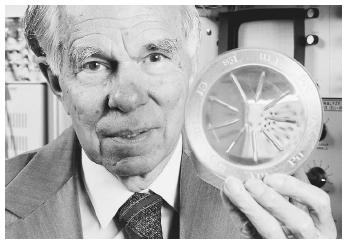Glenn Theodore Seaborg
AMERICAN NUCLEAR CHEMIST
1912–1999
Elder statesman, chemist, and codiscoverer of more elements than any other scientist, Glenn Theodore Seaborg started life in Ishpeming, Michigan, in

1912. In an autobiographical account Seaborg divided his life into eight periods—a notion that perhaps sprang from his consideration of the eight periods of the present Periodic Table. In that account the first two periods correspond to his childhood and youth and conclude with his graduation from UCLA in 1934.
Seaborg went on to the University of California at Berkeley for graduate work, obtaining his Ph.D. in 1937. It was around this time that his interest in transuranium elements (elements of higher atomic number than uranium) took shape. His research interest was in nuclear physics but, as he once said, "one could get a chemistry Ph.D. in those days doing nuclear physics."
Upon finishing his doctoral dissertation, Seaborg went to work as personal research assistant to the chemist Gilbert Newton Lewis. His work with Lewis dealt with the concepts of primary and secondary acids (part of traditional chemistry). However, during his tenure as instructor (1939–1941) and assistant professor (1941) at Berkeley, his research in transuranic elements and isotope production reemerged. During the period 1934 to 1942, Seaborg participated in the discovery of plutonium and its fissionable isotopes (which were essential to the construction of a nuclear bomb). During this period he was also deeply involved in the synthesis of radioactive isotopes from nonradioactive elements 131 I, 60 Co, and 99m Tc, which have found important applications in the diagnosis and treatment of diseases.
From 1942 to 1946, Seaborg, on leave from Berkeley, was employed by the Metallurgical Laboratory, at the University of Chicago. It was during this period that he devised chemical processes for the separation and purification of plutonium. Plutonium, critical to the success of the Manhattan Project , was given the code name "copper." When actual copper was required in the project, the resulting confusion was eliminated by the use of "honest-to-God copper." Also at this time, Seaborg maintained his research on transuranium elements; he took part in the discoveries of both americium (element 95) and curium (element 96). But it was upon his return to Berkeley in 1946 that his transuranium research program gained momentum, whereupon it generated a string of discoveries: berkelium (element 97), californium (98), einsteinium (99), fermium (100), mendelevium (101), and nobelium (102). In 1951 Seaborg and Edwin Mattison McMillan received the Nobel Prize in chemistry "for their discoveries in the chemistry of the transuranium elements."
Between 1953 and 1958 Seaborg served as the faculty athletic representative at the University of California at Berkeley and helped to redesign the Intercollegiate Athletic Union, giving it new rules and regulations that would govern athletic scholarships. From 1958 to 1961, Seaborg served as chancellor at the University of California at Berkeley, during which time he oversaw notable successes in athletics, new building construction, and the establishment of research centers.
From 1961 to 1971, Seaborg was chairman of the United States Atomic Energy Commission. Solicited for the job by President Kennedy, Seaborg at first had doubts about taking on the position. (Seaborg disliked the idea of quitting research.) Kennedy gave him one day to decide. (Seaborg accepted.) His ten years as chairman, during which he served under three presidents and through some of the most turbulent times in U.S. history, established his credentials as an elder statesman.
Seaborg returned to the University of California at Berkeley in 1971. There, in 1974, he discovered with his colleagues one more element. Although it was a controversial discovery due to competing claims, the element was eventually named "seaborgium" (with the result that prior to his death in 1999, Glenn Seaborg was the only living person after whom an element had been named).
In his career he was president of both the American Chemical Society and the American Association for the Advancement of Science. Because of his belief in the importance of education, he undertook to reform the chemistry and science curricula of high schools. CHEM Study, a project designed to improve the teaching of chemistry at the high school level, became an internationally recognized educational resource under his direction. He was a founder of GEMS (Great Explorations in Math and Science) and many other science education projects.
Seaborg worked hard to ensure that science education was not slighted and that science would be seen as a tremendous boon to humanity. Along these lines, it was his leadership that helped to bring into existence the Lawrence Hall of Science at Berkeley as a tribute to Ernest Orlando Lawrence.
SEE ALSO Americium ; Curium ; Lawrence, Ernest ; Plutonium .
Todd W. Whitcombe
Bibliography
Asimov, Isaac (1989). Asimov's Chronology of Science and Discovery. New York: Harper & Row.
Cobb, Cathy, and Goldwhite, Harold (1995). Creations of Fire: Chemistry's Lively History from Alchemy to the Atomic Age. New York: Plenum Press.
Laidler, Keith J. (1998). To Light Such a Candle: Chapters in the History of Science and Technology. New York: Oxford University Press.
Wollaston, George F. (1993). "Glenn Seaborg." Nobel Laureates in Chemistry 1901–1992, ed. Laylin K. James. Washington, DC: American Chemical Society; Chemical Heritage Foundation.
Internet Resources
"Glenn Theodore Seaborg—Biography." Nobel e-Museum. Available from http://www.nobel.se .
Seaborg, Glenn. "Glenn Seaborg: An Autobiographical Account." Available from http://www-ia1.lbl/Seaborg/ .
Comment about this article, ask questions, or add new information about this topic: